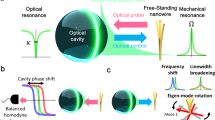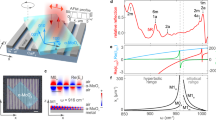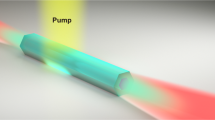Abstract
Subwavelength semiconductor nanowires have recently attracted interest for photonic applications because they possess various unique optical properties and offer great potential for miniaturizing devices. However, realizing tight light confinement or efficient coupling with photonic circuits is not straightforward and remains a challenge. Here we show that a high-Q nanocavity can be created by placing a single III–V semiconductor nanowire with a diameter of under 100 nm in a grooved waveguide in a Si photonic crystal, by means of nanoprobe manipulation. We observe very fast spontaneous emission (91 ps) from nanowires accelerated by the strong Purcell enhancement in nanocavities, which proves that very strong light confinement can be achieved. Furthermore, this system enables us to move the nanocavity anywhere along the waveguide. This configuration provides a significant degree of flexibility in integrated photonics and permits the addition and displacement of various functionalities of III–V nanocavity devices in Si photonic circuits.
This is a preview of subscription content, access via your institution
Access options
Subscribe to this journal
Receive 12 print issues and online access
$259.00 per year
only $21.58 per issue
Buy this article
- Purchase on Springer Link
- Instant access to full article PDF
Prices may be subject to local taxes which are calculated during checkout




Similar content being viewed by others
References
Wagner, R. S. & Ellis, W. C. Vapor–liquid–solid mechanism of single crystal growth. Appl. Phys. Lett. 4, 89–90 (1964).
Lauhon, L., Gudiksen, M., Wang, C. & Lieber, C. Epitaxial core–shell and core–multishell nanowire heterostructures. Nature 420, 57–61 (2002).
Gudiksen, M., Lauhon, L., Wang, J., Smith, D. & Lieber, C. Growth of nanowire superlattice structures for nanoscale photonics and electronics. Nature 415, 617–620 (2002).
Tateno, K., Zhang, G., Gotoh, H. & Sogawa, T. VLS growth of alternating InAsP/InP heterostructure nanowires for multiple-quantum-dot structures. Nano Lett. 12, 2888–2893 (2012).
Heiss, M. et al. Self-assembled quantum dots in a nanowire system for quantum photonics. Nature Mater. 12, 439–444 (2013).
Duan, X., Huang, Y., Cui, Y., Wang, J. & Lieber, C. Indium phosphide nanowires as building blocks for nanoscale electronic and optoelectronic devices. Nature 409, 66–69 (2001).
Wang, J., Gudiksen, M., Duan, X., Cui, Y. & Lieber, C. Highly polarized photoluminescence and photodetection from single indium phosphide nanowires. Science 293, 1455–1457 (2001).
Huang, M. et al. Room-temperature ultraviolet nanowire nanolasers. Science 292, 1897–1899 (2001).
Duan, X., Huang, Y., Agarwal, R. & Lieber, C. Single-nanowire electrically driven lasers. Nature 421, 241–245 (2003).
Oulton, R. F. et al. Plasmon lasers at deep subwavelength scale. Nature 461, 629–632 (2009).
Lu, Y-J. et al. Plasmonic nanolaser using epitaxially grown silver film. Science 337, 450–453 (2012).
Claudon, J. et al. A highly efficient single-photon source based on a quantum dot in a photonic nanowire. Nature Photon. 4, 174–177 (2010).
Nakayama, Y. et al. Tunable nanowire nonlinear optical probe. Nature 447, 1098–1101 (2007).
Yan, R., Gargas, D. & Yang, P. Nanowire photonics. Nature Photon. 3, 569–576 (2009).
Oulton, R. F., Sorger, J. V., Genov, A. D., Pile, D. F. P. & Zhang, X. A hybrid plasmonic waveguide for subwavelength confinement and long-range propagation. Nature Photon. 2, 496–500 (2008).
Barrelet, C. J. et al. Hybrid single-nanowire photonic crystal and microresonator structures. Nano Lett. 6, 11–15 (2006).
Notomi, M. Manipulating light with strongly modulated photonic crystals. Rep. Prog. Phys. 73, 096501 (2010).
Notomi, M. & Taniyama, H. On-demand ultrahigh-Q cavity formation and photon pinning via dynamic waveguide tuning. Opt. Express 16, 18657–18666 (2008).
Yokoo, A., Tanabe, T., Kuramochi, E. & Notomi, M. Ultrahigh-Q nanocavities written with a nanoprobe. Nano Lett. 11, 3634–3642 (2011).
Birowosuto, M. D. et al. Design for ultrahigh-Q position-controlled nanocavities of single semiconductor nanowires in two-dimensional photonic crystals. J. Appl. Phys. 112, 113106 (2012).
Chen, R. et al. Nanolasers grown on silicon. Nature Photon. 5, 170–175 (2011).
Liang, D. & Bowers, J. E. Recent progress in lasers on silicon. Nature Photon. 4, 511–517 (2010).
Park, H-G. et al. A wavelength-selective photonic-crystal waveguide coupled to a nanowire light source. Nature Photon. 2, 622–626 (2008).
Painter, O. et al. Two-dimensional photonic band-gap defect mode laser. Science 284, 1819–1821 (1999).
Noda, S., Chutinan, A. & Imada, M. Trapping and emission of photons by a single defect in a photonic bandgap structure. Nature 407, 608–610 (2000).
Topolancik, J., Ilic, B. & Vollmer, F. Experimental observation of strong photon localization in disordered photonic crystal waveguides. Phys. Rev. Lett. 99, 253901 (2007).
Sapienza, L. et al. Cavity quantum electrodynamics with Anderson-localized modes. Science 327, 1352–1355 (2010).
Gardin, S. et al. Microlasers based on effective index confined slow light modes in photonic crystal waveguides. Opt. Express 16, 6331–6339 (2008).
Smith, C. L. et al. Reconfigurable microfluidic photonic crystal slab cavities. Opt. Express 16, 15887–15896 (2008).
Seo, M-K. et al. Wavelength-scale photonic-crystal laser formed by electron-beam-induced nano-block deposition. Opt. Express 17, 6790–6798 (2009).
Psaltis, D., Quake, S. R. & Yang, C. Developing optofluidic technology through the fusion of microfluidics and optics. Nature 442, 381–386 (2006).
Junno, T., Deppert, K., Montelius, L. & Samuelson, L. Controlled manipulation of nanoparticles with an atomic force microscope. Appl. Phys. Lett. 66, 3627–3629 (1995).
Wolters, J. et al. Enhancement of the zero phonon line emission from a single nitrogen vacancy center in a nanodiamond via coupling to a photonic crystal cavity. Lett. Appl. Phys. 97, 141108 (2010).
Benson, O. Assembly of hybrid photonic architectures from nanophotonic constituents. Nature 480, 193–199 (2011).
Sasakura, H. et al. Longitudinal and transverse exciton-spin relaxation in a single InAsP quantum dot embedded inside a standing InP nanowire using photoluminescence spectroscopy. Phys. Rev. B 85, 075324 (2012).
Shields, A. J. Semiconductor quantum light sources. Nature Photon. 1, 215–223 (2007).
Bleuse, J. et al. Inhibition, enhancement, and control of spontaneous emission in photonic nanowires. Phys. Rev. Lett. 106, 103601 (2011).
Bulgarini, G. et al. Spontaneous emission control of single quantum dots in bottom-up nanowire waveguides. Appl. Phys. Lett. 100, 121106 (2012).
Ford, G. & Weber, W. Electromagnetic interactions of molecules with metal surfaces. Phys. Rep. 113, 195–287 (1984).
Ryu, H. Y. & Notomi, M. Enhancement of spontaneous emission from the resonant modes of a photonic crystal slab single-defect cavity. Opt. Lett. 28, 2390–2392 (2003).
Englund, D. et al. Controlling the spontaneous emission rate of single quantum dots in a two-dimensional photonic crystal . Phys. Rev. Lett. 95, 013904 (2005).
Badolato, A. et al. Deterministic coupling of single quantum dots to single nanocavity modes. Science 308, 1158–1161 (2005).
Matsuo, S. et al. High-speed ultracompact buried heterostructure photonic-crystal laser with 13 fJ of energy consumed per bit transmitted . Nature Photon. 4, 648–654 (2010).
Nozaki, K. et al. Ultralow-power all-optical RAM based on nanocavities . Nature Photon. 6, 248–252 (2012).
Babinec, T. M. et al. A diamond nanowire single-photon source. Nature Nanotech. 5, 195–199 (2010).
Acknowledgements
We acknowledge S. Fujiura and M. Ono for assistance with the NW manipulation and W.J. Munro for discussions.
Author information
Authors and Affiliations
Contributions
M.D.B., A.Y., G.Z. and M.N. conceived the idea and designed the experiments. M.D.B. performed the simulation, conducted the experiments and analysed the data. M.D.B. and M.N. wrote the manuscript. A.Y. manipulated the nanowires. K.T. conducted the NW growth. G.Z. and E.K. were involved in the fabrication processes. M.T. supported the experiments. H.T. supported the simulation. M.N. guided the project.
Corresponding author
Ethics declarations
Competing interests
The authors declare no competing financial interests.
Supplementary information
Supplementary Information
Supplementary Information (PDF 1671 kb)
Rights and permissions
About this article
Cite this article
Birowosuto, M., Yokoo, A., Zhang, G. et al. Movable high-Q nanoresonators realized by semiconductor nanowires on a Si photonic crystal platform. Nature Mater 13, 279–285 (2014). https://doi.org/10.1038/nmat3873
Received:
Accepted:
Published:
Issue Date:
DOI: https://doi.org/10.1038/nmat3873
This article is cited by
-
Spontaneous emission in micro- or nanophotonic structures
PhotoniX (2021)
-
Photonic-crystal optical parametric oscillator
Nature Photonics (2021)
-
Self-organized phase-transition lithography for all-inorganic photonic textures
Light: Science & Applications (2021)
-
Ultra-coherent Fano laser based on a bound state in the continuum
Nature Photonics (2021)
-
Two-dimensional materials for light emitting applications: Achievement, challenge and future perspectives
Nano Research (2021)



